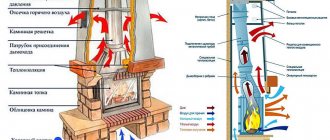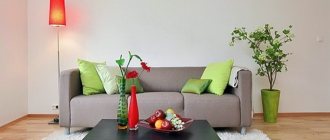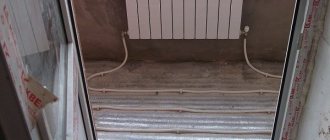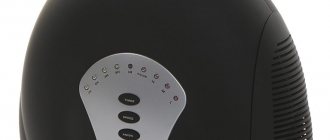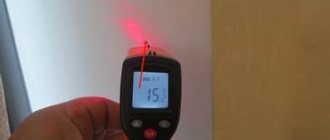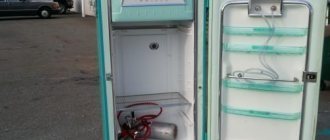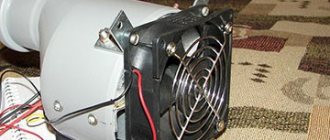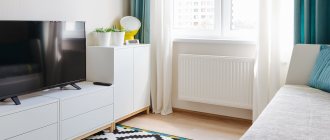You need to constantly monitor the normal air humidity in the apartment, because your health and comfortable living depend on it. Few people think about humidity indicators, but they are just as important as noise levels and lighting.
The consequences of a lack of moisture become immediately noticeable, especially in winter. The skin and mucous membranes of the nose become dry, a sore throat and inflammation of the eyes may occur. This especially negatively affects children and can lead to the development of bronchitis or asthma.
Later in this article we will consider in detail information about what the normal level of humidity should be in rooms, how to measure it, raise or lower it in order to obtain optimal indicators for our body.
The humidity level in the apartment is normal
The air we breathe is always filled to some extent with water vapor (we, of course, do not take into account desert regions that are not suitable for human life). Air humidity indicates the content of these vapors. It can be absolute and relative.
If we measure the volume of water in a cubic meter of air, we know its absolute humidity. Let's imagine that we took one cubic meter of air and found 13 g of water in it. This 13 g/m3 is its absolute humidity.
But if we want to calculate the relative humidity of the air, we will need to know two values: the maximum possible volume of water in a cubic meter of air (it depends on the temperature: the higher it is, the more moisture the air can hold) and the actual volume of water in a given cubic meter of air.
The percentage of the actual volume to the maximum possible will be the relative humidity of the air. For example, a cubic meter of air at a temperature of 24°C can contain a maximum of 21.8 g of water. If we find 13 g of water in it, then its relative humidity is about 60%.
What is the norm of humidity in an apartment indicated in official sources? Construction standards for Russia are prescribed in interstate GOST 30494-96 “Residential and public buildings. Indoor microclimate parameters."
According to this document, the optimal relative humidity in the cold season is 30-45%, and in the warm season – 30-60%. GOST also specifies limit values: in winter, according to the authors, it should not exceed 60%, and in summer – 65%.
It is worth remembering that the figures indicated by GOST are intended primarily not for residents of buildings, but for those who design and maintain these buildings.
This can be seen, for example, by the fact that the GOST standard for humidity in an apartment is lower in winter than in summer. This is due to the fact that during the cold season, the relative humidity of the outdoor air drops significantly when it warms up to room temperature.
It is difficult to design and maintain a building so that it can maintain “summer” humidity standards in winter without significant costs. But this does not mean that in winter the human body needs less moisture.
Physiologists recommend maintaining humidity in the apartment at 40-60%, regardless of the time of year.
How much humidity should be in the room? 30% humidity - the lower limit of the norm according to GOST - is felt by many as dry air with all the accompanying consequences. This humidity is also insufficient for most indoor plants: they will begin to dry out and wither. The optimal humidity for indoor flowers common in our latitudes is 40-70%.
Normal air humidity in an apartment in winter
- Particular attention should be paid to the issue of air humidity in the winter season. As we saw above, it is significantly lower due to a number of reasons, namely:
- radiator heating;
- additional heating devices;
- restriction in the flow of fresh air due to closed or sealed plastic windows.
All these factors affect not only the comfortable humidity in the apartment, but can also become an invisible source of health problems.
Acceptable humidity levels in premises are limited by the quantitative values specified in SanPiN. During inspections, measurements are carried out in accordance with GOST methods. Acceptable values for housing located in different climatic zones differ, and the required standards are not the same at different times of the year.
What percentage of humidity should be in the apartment?
Sanitary standards regulate the maximum relative humidity permissible in living rooms, which is 65% in summer, and 60% in the cold season.
Physiologists draw attention to the need to control minimum indicators, which at any time of the year should not be less than 40%. It is believed that ideal parameters for living rooms should have average values between 40% and 60%.
In winter, when heating a room, be it a private house or apartment, the humidity can drop sharply due to dry air. This must be monitored, if necessary, turning on the humidifier, opening the window for ventilation or installing baths with water.
In the winter season, any living space is heated. In the northern regions of the country it is especially intense due to severe frosts. Heat from radiators or underfloor heating dries out the air. This can be determined quite simply - drying out of the nasal and nasopharyngeal mucosa, this is especially noticeable after sleep.
It is these factors that lead not only to discomfort, but also to an increased risk of acute respiratory infections. We are more vulnerable when we sleep, so it is best to humidify the air at night or in the evening.
The optimal temperature for a full stay is considered to be +18…+24°C. Normal air humidity in the apartment should be 45−30%. The maximum allowable is 60%.
Air humidity in the apartment is normal for a child
A child's body copes worse with harmful environmental factors than an adult. Children freeze faster and overheat faster, catch colds easily, catch infections more often and suffer more severe illnesses.
Therefore, the microclimate in the nursery should help maintain the child’s body’s defenses, and humidity plays an important role here. The air should never be dry. In dry air, the child’s body intensively loses moisture.
The mucous membranes of the nasopharynx dry out and lose their ability to resist infections, the baby may experience itching in the eyes, and peeling may appear on sensitive skin.
The normal humidity level in an apartment for a child is considered to be 50-60%.
The famous children's doctor Evgeny Komarovsky insists on more: he calls 60% humidity the norm for a healthy child and recommends 70% for a baby who has caught an infection (the higher the air humidity, the less the mucous membranes dry out).
Important! Exceeding 24°C in a children's room can lead to overheating of the baby's body. As a result, drying of the mucous membranes and loss of fluid will accelerate.
The norm of humidity for a child in winter does not differ from summer. But there is an important point: in both winter and summer, it is advisable to maintain the temperature in the children’s room at no higher than 24°C. If the room is warmer, then a humidity of 60% will turn the nursery into the tropics.
You probably know from your own experience that high humidity is much more difficult to tolerate in hot weather than in cold weather. In addition, exceeding the specified temperature norm can cause overheating of the child’s body, which will, again, lead to loss of fluids, drying out of the mucous membranes and skin.
Comfortable indoor humidity for humans
The optimal level of air humidity is one of the components that ensure comfortable climatic conditions for human habitation. Moreover, each room, depending on its purpose, has its own microclimate.
Most often, people worry about the temperature and quality of air masses in the house, forgetting about this indicator. But it is the number of water (steam) molecules in the air that affects the perception of temperature by the human body, the safety of the indoor environment and the condition of plants.
Many people think that air humidity is an almost invisible indicator in the house, but this is not so. Surely many have seen the formation of condensation on glass during the cold season. This condensate is the excess moisture in the air.
It tends to condense where objects are coldest. This is why we see droplets on the windows.
The generally accepted average normal air humidity in an apartment should be 45%. It may vary depending on the type of room and its operating conditions.
Deviation from the norm is possible both in the winter season and in the warm period. In both cases, a lack or excess of humidity entails deterioration in human health, the condition of plants and damage to furniture, decoration, etc.
What should be the humidity in the apartment?
Optimal humidity and temperature parameters for individual rooms:
| Room | Air temperature, °C | Air humidity, % |
| Bedroom | 16-20 | 40-55 |
| Children's | 18-24 | 50-60 |
| Living room | 18-23 | 40-50 |
| Kitchen | 19-22 | 40-50 |
| Bathroom | 21-23 | 40-50 |
| Toilet | 16-19 | 40-45 |
| Study | 18-22 | 30-40 |
| Hallway | 18-19 | 40-45 |
| Greenhouse | 16-25 | 50-70 |
Rooms such as the kitchen, bathroom and toilet will always have a high level of moisture, so the standard for these rooms is higher than for other rooms.
Deviations from normal humidity have negative consequences. Thus, a low liquid content in the air leads to a large amount of liquid in the room. This is harmful not only from an aesthetic point of view, but also due to the negative impact on health, especially for those with allergies. Dry and dusty air can cause serious illnesses!
In addition, excessive dryness is fraught with damage to the skin and mucous membranes. If the comfortable air humidity is exceeded, a person will feel uncomfortable, furniture and antique items will be stored much worse than with normal liquid content in the room.
And also excessively humid air will become a real haven for all kinds of bacteria, including pathogenic ones. It causes the appearance of fungus and mold, dampness.
- In order for a person, plant or animal to be comfortable in a room, air humidity must be within certain limits:
- for people: 40-70%;
- for plants: 50-75%;
- for books, equipment, furniture: 40-60%.
How to measure air humidity in an apartment
- To determine how much the air humidity level in the house has deviated, you can do without a special device and use:
- a glass of water;
- fir cone;
- thermometer and Assmann table.
1. To determine the relative humidity of the air using a glass of water, it is necessary to cool the filled container in the refrigerator to 5°C. It will take about 3 hours for the water and the vessel to reach the specified temperature. After this, the glass is placed on the table away from the radiator. Within 5 minutes, condensation will form on the walls of the container.
- Further results will depend on the behavior of this condensate:
- After a few minutes, the glass has dried - the humidity level has decreased.
- The condensation on the walls has not disappeared - the room has a normal microclimate.
- Drops flowed down the vessel in streams - there was an excess of moisture in the air.
2. A fir cone can serve as a measuring device. It should be placed away from heating devices and after a few hours the condition of the scales should be checked. If the air is too dry, the cone will open; if there is too much moisture, the scales will shrink tightly. 3. More accurately, humidity can be determined by readings from dry and wet thermometers. Record the temperature on a thermometer installed in the room. After this, wrap the end containing the mercury with a damp cloth. After 5 minutes, check the result. If it turns out to be higher than the previous one, it means that you did not wet the cloth very well. In this case, repeat the process. Write down the result. Then check the Assmann chart. In the left column of the table are the values of the dry thermometer, at the top is the temperature difference in degrees between the dry and wet thermometers. The temperature intersection point will show the approximate humidity
All of these devices only indirectly indicate the presence of a problem. To accurately determine the microclimate in a room, it is better to buy an air humidity sensor.
The primary sign of dry air is dry tips of plants. Also, insufficient moisture levels can be determined by synthetic clothing, which in such conditions emits electrical charges.
A device for measuring humidity in an apartment
A thermohygrometer is a complex device that measures not only air humidity, but also room temperature. Among other things, a thermohygrometer can record readings about the state of temperature and humidity from different points. That is, directly from the place where the thermohygrometer itself is installed and from the point where the additional sensor is installed.
The device synchronizes readings received from different points in the room, and based on this, it already provides results for checking humidity levels and measuring temperature.
A few words can be said about the technical characteristics of the thermohygrometer. The cable of this device is several meters long, and the indicators are displayed in the range from 0 to 90%. There are also wireless models of thermohygrometers.
These devices are equipped with another useful function, which is that when the humidity in the room is critical, an alarm is triggered, notifying about an unfavorable change in the air condition.
Psychrometer, also called psychrometric hygrometer. It consists of two thermometers. One is called “dry” and measures air temperature. The second is called moistened because it is wrapped in a cloth wick and immersed in a vessel of water.
This thermometer shows the temperature of the wet wick. Humidity indicators are derived from the evaporation of moisture. The lower the air humidity in the room, the more intensely the moisture evaporates. And as a result of these processes, it is possible to obtain the necessary data on both air temperature and humidity.
Hair and film hygrometers. The operating principle of a hair hygrometer is quite simple and at the same time very interesting. It consists in the presence in the mechanism of the device of synthetic fat-free hair, which tends to change length depending on the air condition.
The hair is stretched between the spring and the end of the arrow. When there is a hairline vibration, the needle moves across the dial, showing data on the state of the air.
This device for determining humidity has a fairly wide range of values (from 0 to 100%), which indicates the accuracy of the hair hygrometer readings. One of the biggest advantages of such devices is its simplicity.
Hair hygrometers are very easy to use, which will avoid unnecessary headaches during its operation. We can also mention once again the accuracy of his testimony. Hair hygrometers can be hung on the wall.
In addition to hair hygrometers, there are film hygrometers. Their devices are different, and therefore the principle of operation of film hygrometers is somewhat different. Such devices have a sensitive element made of organic film.
This material has the property of stretching or shrinking depending on the state of air humidity. The indicators are displayed on the dial when the position of the center of the film sensitive element changes.
If the conditions in which the device will be used to determine air humidity include the presence of relatively low temperatures, then the two types of hygrometers described above will be the only devices that will be able to measure the level of air humidity in the room.
Optimal air humidity in an apartment for a child
The level of humidity in the apartment in which the child lives is a very significant indicator. The health of the baby and the peace of his relatives depend on it.
The fact is that the child’s body undergoes a thermoregulation procedure in a special way, so dry air can negatively affect it. The air that a baby exhales has one hundred percent humidity and body temperature. If the humidity of the surrounding space is low, the child will have to spend a lot of internal fluid to humidify the air. Loss of water from a child’s body can lead to unpleasant consequences that are best avoided. The more humidified the air, the less money we will spend on medicines. This is a rule that should be taken as a basis.
In your child's room, you should strive to maintain the humidity level between 50-70%. Only in this case, and also provided that the air temperature is at 24 degrees during the day and about 19–20 at night, can we hope for the rare occurrence of colds. In addition, in such a microclimate the child will sleep better and longer.
A certain level of humidity must be constantly maintained in the children's room.
To maintain this level, you can use any of the following methods:
- regular wet cleaning;
- presence of an aquarium;
- wet towels on radiators or bowls of water in the room;
- modern humidifiers.
Maintaining the necessary humidity in a children's room is not at all a difficult task, and the presence of undeniable advantages makes every parent strive to achieve it.
How to humidify the air at home without a humidifier
How to reduce indoor humidity
If the humidity level in the apartment is higher than normal, you can purchase a special device - a dehumidifier. It forces humid air through an “evaporator”, where the temperature difference (the temperature in the device is lower than in the room) turns the moisture into condensation. Drops of condensate flow into a special container.
The air is heated again and enters the room. Thus, excess moisture disappears from the room. When purchasing a dehumidifier, the main consideration is its performance, which is measured in “liters per day.”
A household dehumidifier can absorb between 12 and 300 liters of water in 24 hours. Dehumidifiers can be portable or stationary. Portable ones can be used in different rooms. Stationary ones are mounted in the wall and cannot be moved. At the same time, they have greater productivity.
The advantage of dehumidifiers is their ability to function in cold rooms, since frost formed during operation is removed automatically. If the water tank is filled and not emptied in a timely manner, the device turns off without the intervention of the owner.
In a small room, you can reduce humidity using moisture absorbers. The device includes a special tablet that adsorbs water from the air.
It is designed for an area of up to 20 m² on average. The disadvantage of the absorber is that the tablet needs to be changed frequently. The advantage is the absence of noise, compactness and price. The moisture absorber is especially suitable for those who experience humidity as a seasonal phenomenon.
Folk remedies for reducing humidity
Among the folk remedies, the simplest one is regular ventilation. The more often it is carried out, the drier the air will become. Even if the humidity outside is higher than at home, when airing the apartment it decreases. The bathroom and toilet are unventilated areas.
They are equipped with hoods for air circulation. However, they do not always cope with the amount of work. Therefore, it would be a good idea to install an exhaust fan.
An oil radiator with a built-in fan will dry the humid air in a small room. The required temperature and humidity level will be maintained by the installed air conditioner.
The sun's rays through uncurtained windows in rooms can dry the air well. The kitchen can also be equipped with extraction systems. They not only help in the fight against humidity, but also remove excess odors.
Feeling comfortable at home is very important for any person. High-quality air in the apartment has a positive effect on the well-being of residents, helping to avoid chronic diseases and allergic reactions to dust or mold. Therefore, it is very important to determine the humidity level in your home and then maintain it at normal levels.
What are the consequences of exceeding the norm for indoor humidity?
An excess of water can also be dangerous for humans, so many people wonder what air humidity is considered normal in an apartment and how to maintain climatic conditions within this indicator. An increased content of water vapor in a room becomes an excellent breeding ground for fungi, mold and harmful bacteria.
- In such conditions, many problems arise:
- The frequency and severity of respiratory diseases is increasing - diseases such as bronchitis, runny nose, allergies and asthma become chronic and difficult to treat.
- The microclimate in the rooms becomes unacceptable for life - people feel damp or stuffy in the rooms.
- The feeling of freshness is lost - the secretions of multiplying pathogenic organisms cause the appearance of unpleasant odors.
- The drying time for washed clothes increases.
Increased air humidity in the apartment is also harmful to the environment. Plants begin to rot, mold appears on the ceiling and walls, and wooden surfaces undergo deformation changes. Books and other paper products change their structure.
How to maintain indoor humidity
To create the necessary humidity in the room, special equipment is used. These can be small humidifiers for one room, or entire systems can be used to maintain the humidity of production facilities, greenhouses and greenhouse farms, and large business facilities.
To determine the humidity in a room, there are special devices called hygrometers or psychrometers. In most cases, hygrometers are used, which are often built into humidifiers, to organize automatic maintenance of humidity in the room being served.
There are a sufficient number of different types of humidifiers on the modern market, but the most advanced and adapted for most residential, office premises, and many other facilities are ultrasonic humidifiers, which create fine mist of excellent quality.
The hygrometer constantly measures the state of relative humidity, the signal from it is sent to a relay configured for minimum and maximum readings, upon reaching which it turns the humidifier on or off. The device creates water mist, which enters the room until the specified humidity is reached, after which it turns off. The presence of a person is only necessary to turn on the humidifier for the first time, setting the required parameters, and to replenish the water in the humidifier tank.
How to increase humidity in an apartment
The most optimal and modern way to increase the humidity in the apartment is to buy an air humidifier. This device is designed mainly for rooms up to 150 m³. Water is poured into a special container of the humidifier, which evaporates when the device operates.
- Humidifiers are:
- traditional;
- steam;
- ultrasonic.
Traditional (mechanical) ones, using a built-in fan, drive air through a container of water, where it is moistened and cleaned of dust. The disadvantage of a mechanical humidifier is the limited level of humidification (no more than 60%) and high noise.
A steam humidifier works on the principle of a kettle. The water boils in it and comes out in the form of steam. The disadvantages of such models are hot steam (up to 60° C), high noise and high power consumption.
However, a steam humidifier can use even very dirty or hard water. Some models have special attachments that allow you to use the device as an inhaler. You can increase the air humidity with a steam humidifier above 60%.
An ultrasonic humidifier uses a special membrane to convert water into steam. It is not as noisy as mechanical or steam models. The water heating function helps fight germs in the air.
The disadvantage of an ultrasonic humidifier is that it only requires distilled water or special cartridges for cleaning and softening water, which must be changed regularly.
How to increase humidity with folk remedies
Folk remedies for air humidification will be an excellent help for those who have not yet acquired a special device for regulating the humidity in the room.
The most common way is to place a wet towel or sheet on the radiator. The fabric heats up and the water begins to evaporate. When the towel is dry, you need to wet it again.
If you don’t want to go to the bathroom every time the fabric dries, you can place containers of water on the radiators. In this case, you will need to add water every few days.
From containers with water placed on pieces of furniture (on cabinets, for example), evaporation occurs more slowly, but the humidity still increases.
You can place a bowl of water near the battery. The end of a bandage folded in several rows is lowered into it. The other end is located on the battery. The water constantly rises up the bandage and evaporates from the heat.
- Household items also help to humidify the air. Among them:
- drying clothes in the room;
- growing indoor plants that give off moisture on their own and require daily spraying;
- installation of an aquarium;
- the bathroom door, open after a shower, allows moisture to escape into the rooms;
- purchasing a small decorative fountain;
- insulation of the apartment (walls, window frames).
What are the consequences of a deviation from the norm of humidity in an apartment: dry air?
When the radiators are turned on, the indoor air becomes dry. As a result, the mucous membranes of the throat and nasal cavity become irritated in residents. Drying of hair and skin is observed.
When the humidity level in a living room is violated, static electricity is generated, which raises dust particles into the air. This process can become the basis for the spread of germs and dust mites.
- Excessive dryness of the room entails many negative consequences:
- decreased elasticity of the skin, nails and hair - as a result, dermatitis, peeling, microcracks and premature wrinkles appear;
- drying out of the mucous membrane of the eyes - redness, unpleasant itching and a sensation of foreign bodies (“sand”);
- the blood thickens - because of this, blood circulation slows down, a person develops weakness and headaches. There is a decrease in performance, the heart is subjected to increased stress and wears out faster;
- the viscosity of intestinal and gastric juice increases - the work of the digestive system slows down significantly;
- dryness of the respiratory tract - as a result, local immunity is weakened, and the likelihood of colds and infectious diseases increases;
- air quality decreases - a large number of allergens are concentrated in the air masses, which, at normal air humidity in the room, are bound by water particles.
Note! Plants and animals living near the apartment suffer from lack of moisture. The service life of wooden furniture and decoration is reduced, they fade and become cracked.
Problems arising from lack or excess moisture
Dry indoor air provokes increased moisture loss through the skin and respiratory tract. This can lead to such unpleasant consequences as:
- decreased elasticity of hair, nails and skin, accompanied by the appearance of microcracks, wrinkles, peeling, dermatitis;
- drying of the mucous membrane of the eyes, the symptoms of which are itching, redness, and a feeling of “sand”;
- thickening of the blood, leading to a slowdown in blood circulation, weakness, headaches, decreased performance, and increased stress on the heart;
- an increase in the viscosity of gastric and intestinal juices, causing a slowdown in digestion;
- drying out of the mucous membranes of the respiratory tract, which results in a weakening of local immunity and an increase in the frequency of acute respiratory viral infections;
- an increase in the amount of respiratory allergens in the atmosphere, which should normally be bound by liquid droplets.
Excess moisture in the air creates acceptable conditions for the growth of mold, fungi, and bacteria. As a result, you may encounter the following problems:
- 630
More details - 234
More details
- 234 210
More details
- 630
More details
- respiratory diseases - chronic runny nose, bronchitis, asthma, allergies; feeling of stuffiness or dampness in the room;
- unpleasant odor due to the proliferation of pathogenic microorganisms;
- increasing the drying time of washed laundry.
Excessive or insufficient amount of moisture in the house has a bad effect on the condition of home furnishings. Plants dry out or begin to rot, wooden furniture and parquet floors become deformed or “shrink,” paintings fade, paper products lose their structure.



